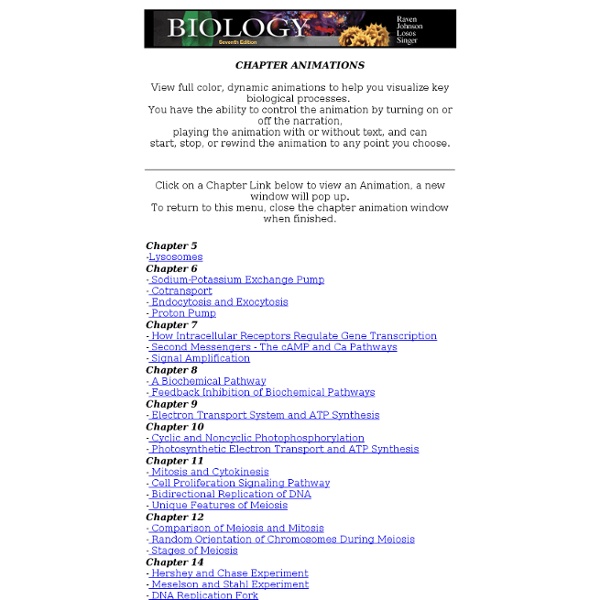



GENÉTICA MOLECULAR Puedes consultar en el siguiente enlace las orientaciones sobre la asignatura para este curso Biología 09-10 Los Niveles de Organización de los seres vivos. Los Niveles Ecológicos Tutoriales: Átomos, iones y la tabla periódica Tipos de enlaces. Importancia de la estructura en las moléculas Los glúcidos, lípidos, prótidos y Ac. El agua, composición, estructura y propiedades Animaciones: Difusión de un soluto ¿Por qué se disuelven las sales? Ciclación de la glucosa al disolverse Las macromoléculas biológicas: glúcidos, lípidos, prótidos y ac. nucleicos, su composición y estructura. Estructura del ADN y desespiralización del ADN Ósmosis Sustancias buffer o tampón Las enzimas : Qué son las enzimas, enzimas alostéricas y tipos de inhibidores. Enzimas1 y Enzimas 2 : Interesante el apartado sobre modelos de unión enzima-sustrato. Mecanismo de la actividad enzimática Al índice Tutorial: Estructura celular Ejercicios: Componentes de la célula animal (elegir "Ejecutar" cuando pregunten que desea hacer con el archivo)
uWall.tv | Listen to a Wall of Music © 2021 - Privacy - Terms Interactive Animal and Plant Cells Nucleolus: The prominent structure in the nucleus is the nucleolus. The nucleolus produces ribosomes, which move out of the nucleus and take positions on the rough endoplasmic reticulum where they are critical in protein synthesis. Cytosol: The cytosol is the "soup" within which all the other cell organelles reside and where most of the cellular metabolism occurs. Cytoplasm: This is a collective term for the cytosol plus the organelles suspended within the cytosol. Centrosome: The centrosome, or MICROTUBULE ORGANIZING CENTER (MTOC), is an area in the cell where microtubules are produced. During animal cell division, the centrioles replicate (make new copies) and the centrosome divides. Centriole (animal cells only): Each centriole is a ring of nine groups of fused microtubules. Golgi: The Golgi apparatus is a membrane-bound structure with a single membrane. Lysosome: Lysosomes contain hydrolytic enzymes necessary for intracellular digestion.
Spanish Animations Spanish Animations Copyright ©2007 McGraw-Hill Higher EducationAny use is subject to the Terms of Use and Privacy Policy.McGraw-Hill Higher Education is one of the many fine businesses of The McGraw-Hill Companies. Inquiry into Biology <hr><p><b>You must have javascript enabled to view this website. Please change your browser preferences to enable javascript, and reload this page.</b></p><hr> Inquiry into Biology Robert Constantin, Writer/EducatorHelen Colbourne, Forest Lawn High SchoolDarcy Dobell, Professional Writer/EducatorClaudia Fehres, William Aberhart High SchoolDeborah MacFadyen, Jack James High SchoolGeorge Thomson, Crescent Heights High SchoolAdrienne Mason, Professional WriterAlexandra Venter, Professional Writer Welcome to the Student Centre for Inquiry Into Biology. Now Available: Unit PreparationUnit PreQuizzes Web LinksAnimations and Virtual Lab ExercisesIllustrations from the Student Edition Please navigate through the content by choosing an option from the Navigation bar on the left.
A Science Odyssey: You Try It: DNA Workshop An embryonic cell divides again and again. Where there was one cell there are two, then four, then eight,... Each holds all the genetic information needed to create a human being. Hair grows from your head, nonstop, day in and day out. The answers to these questions are DNA replication and protein synthesis. Knowledge of the structure of DNA began with the discovery of nucleic acids in 1869. The activity in this section places you within the cell, involving you with the processes of DNA replication and protein synthesis. If you're interested in finding out more about DNA and protein synthesis, check out the other sections. Related People and Discoveries entries
Proyecto Biosfera La Materia viva. Bioelementos. Principios inmediatos y biomoléculas. El agua y las sales minerales. Glúcidos: concepto, clasificación y función. Online Courses - Distance Learning - Επιμόρφωση Β΄ επιπέδου στις ΤΠΕ